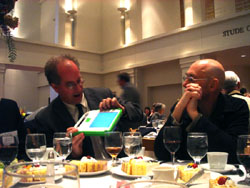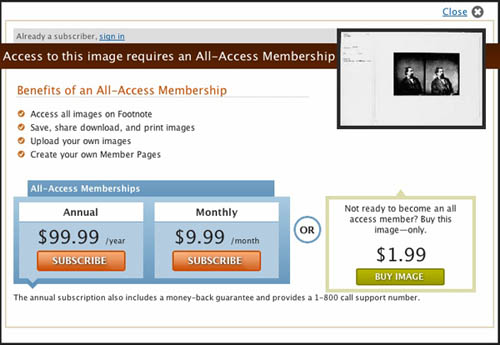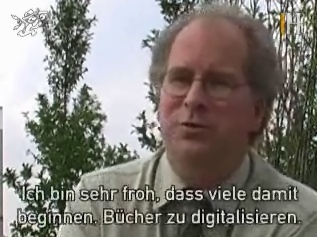Peter Brantley relates the frustrating experience of trying to hunt down a particular passage in a book and his subsequent painful collision with the cold economic realities of publishing. The story involves a $58 paperback, a moment of outrage, and a venting session with an anonymous friend in publishing. As it happens, the venting turned into some pretty fascinating speculative musing on the future of books, some of which Peter has reproduced on his blog. Well worth a read.
 A particularly interesting section (quoted further down) is on the implications for publishers of on-demand disaggregated book content: buying or accessing selected sections of books instead of entire volumes. There are numerous signs that this will be at least one wave of the future in publishing, and should probably prod folks in the business to reevaluate why they publish certain things as books in the first place.
A particularly interesting section (quoted further down) is on the implications for publishers of on-demand disaggregated book content: buying or accessing selected sections of books instead of entire volumes. There are numerous signs that this will be at least one wave of the future in publishing, and should probably prod folks in the business to reevaluate why they publish certain things as books in the first place.
Amazon already provides a by-the-page or by-the-chapter option for certain titles through its “Pages” program. Google presumably will hammer out some deals with publishers and offer a similar service before too long. Peter Osnos’ Caravan Project includes individual chapter downloads and print-on-demand as part of the five-prong distribution standard it is promoting throughout the industry. If this catches on, it will open up a plethora of options for readers but it might also unvravel the very notion of what a book is. Could we be headed for a replay of the mp3’s assault on the album?
The wholeness of the book has to some extent always been illusory, and reading far more fragmentary than we tend to admit. A number of things have clouded our view: the economic imperative to publish whole volumes (it’s more cost-effective to produce good aggregations of content than to publish lots of individual options, or to allow readers to build their own); romantic notions of deep, cover-to-cover reading; and more recently, the guilty conscience of the harried book consumer (when we buy a book we like to think that we’ll read the whole thing, yet our shelves are packed with unfinished adventures).
But think of all the books that you value just for a few particular nuggets, or the books that could have been longish essays but were puffed up and padded to qualify as $24.95 commodities (so many!). Any academic will tell you that it is not only appropriate but vital to a researcher’s survival to hone in on the parts of a book one needs and not waste time on the rest (I’ve received several tutorials from professors and graduate students on the fine art of fileting a monograph). Not all thoughts are book-sized and not all reading goes in a straight line. Selective reading is probably as old as reading itself.
Unbundling the book has the potential to allow various forms of knowledge to find the shapes and sizes that fit them best. And when all the pieces are interconnected in the network, and subject to social discovery tools like tagging, RSS and APIs, readers could begin to assume a role traditionally played by publishers, editors and librarians — the role of piecing things together. Here’s the bit of Peter’s conversation that goes into this:
Peter: …the Google- empowered vision of the “network of books” which is itself partially a romantic, academic notion that might actually be a distinctly net minus for publishers. Potentially great for academics and readers, but potentially deadly for publishers (not to mention librarians). As opposed to the simple first order advantage of having the books discoverable in the first place – but the extent to which books are mined and then inter-connected – that is an interesting and very difficult challenge for publishers.
Am I missing something…?
Friend: If you mean, are book publishers as we know them doomed? Then the answer is “probably yes.” But it isn’t Google’s connecting everything together that’s doing it. If people still want books, all this promotion of discovery will obviously help. But if they want nuggets of information, it won’t. Obviously, a big part of the consumer market that book publishers have owned for 200 years want the nuggets, not a narrative. They’re going, going, gone. The skills of a “publisher” — developing content and connecting it to markets — will have to be applied in different ways.
Peter: I agree that it is not the mechanical act of interconnection that is to blame but the demand side preference for chunks of texts. And the demand is probably extremely high, I agree.
The challenge you describe for publishers – analogous in its own way to that for libraries – is so fundamentally huge as to mystify the mind. In my own library domain, I find it hard to imagine profoundly differently enough to capture a glimpse of this future. We tinker with fabrics and dyes and stitches but have not yet imagined a whole new manner of clothing.
Friend: Well, the aggregation and then parceling out of printed information has evolved since Gutenberg and is now quite sophisticated. Every aspect of how it is organized is pretty much entirely an anachronism. There’s a lot of inertia to preserve current forms: most people aren’t of a frame of mind to start assembling their own reading material and the tools aren’t really there for it anyway.
Peter: They will be there. Arguably, when you look at things like RSS and Yahoo Pipes and things like that – it’s getting closer to what people need.
And really, it is not always about assembling pieces from many different places. I might just want the pieces, not the assemblage. That’s the big difference, it seems to me. That’s what breaks the current picture.
Friend: Yes, but those who DO want an assemblage will be able to create their own. And the other thing I think we’re pointed at, but haven’t arrived at yet, is the ability of any people to simply collect by themselves with whatever they like best in all available media. You like the Civil War? Well, by 2020, you’ll have battle reenactments in virtual reality along with an unlimited number of bios of every character tied to the movies etc. etc. etc. I see a big intellectual change; a balkanization of society along lines of interest. A continuation of the breakdown of the 3-television network (CBS, NBC, ABC) social consensus.

 (Speaking of the IA, Brewster Kahle is also here and is closing the conference Wednesday afternoon. He brought with him a test model of the hundred dollar laptop, which he showed off at dinner (pic to the right) in tablet mode sporting an e-book from the Open Content Alliance’s children’s literature collection (a scanned copy of The Owl and the Pussycat)).
(Speaking of the IA, Brewster Kahle is also here and is closing the conference Wednesday afternoon. He brought with him a test model of the hundred dollar laptop, which he showed off at dinner (pic to the right) in tablet mode sporting an e-book from the Open Content Alliance’s children’s literature collection (a scanned copy of The Owl and the Pussycat)).
